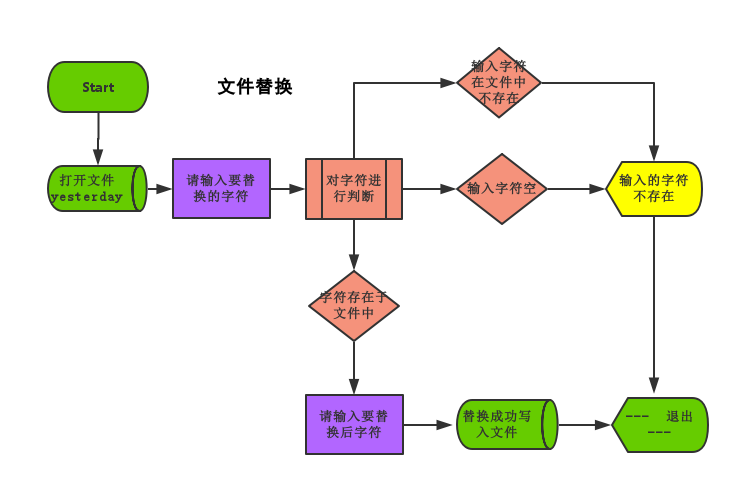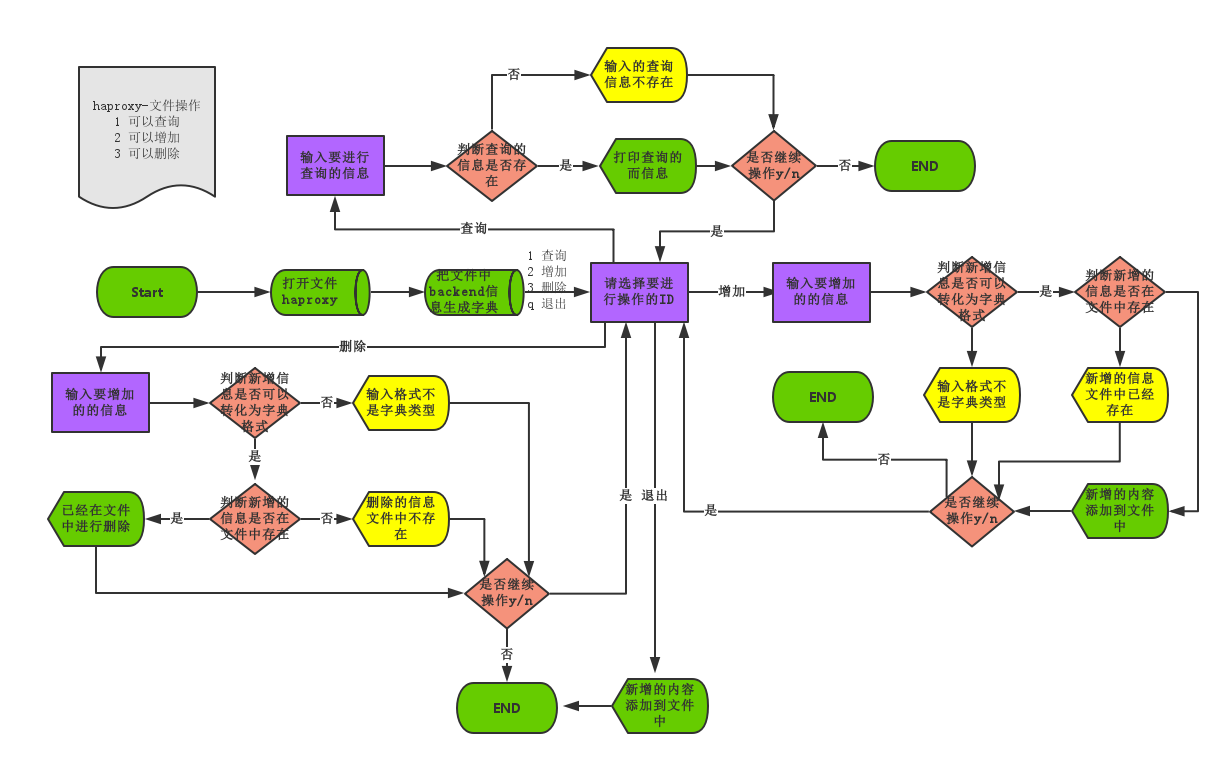Python开发【第三章】:文件操作
转载自:https://www.cnblogs.com/lianzhilei/p/5749932.html
一、文件操作模式概述
1、打开文件的模式:
- r, 只读模式【默认】
- w,只写模式【不可读;不存在则创建;存在则删除内容;】
- a, 追加模式【不可读;不存在则创建;存在则只追加内容;】
2、"+" 同时读写某个文件:
- r+,可读写文件。【可读;可写;可追加】
- w+,写读
- a+,追加读
3、"U"表示在读取时,可以将 \r \n \r\n自动转换成 \n (与 r 或 r+ 模式同使用)
- rU
- r+U
4、"b"表示处理二进制文件(如:FTP发送上传ISO镜像文件,linux可忽略,windows处理二进制文件时需标注)
- rb
- wb
- ab
二、文件操作常用功能
注:默认以下操作都是基于下面文件操作的:

我越无所适从
越会事与愿违
在交错的时空
灵魂加速下坠
Here we are, here we are, here we are
1、read()、readline()、readlines()的区别
|
1
2
3
4
5
6
7
8
9
10
11
12
13
14
15
16
17
18
19
|
#!/usr/bin/env python# -*- coding:utf-8 -*-#-Author-Lianinfo_file = open("here_we_are",encoding="utf-8") #默认读取模式print(info_file) #不加参数,直接打印#<_io.TextIOWrapper name='here_we_are' mode='r' encoding='utf-8'>print(info_file.read()) #read参数,读取文件所有内容#我越无所适从#越会事与愿违#在交错的时空#灵魂加速下坠#Here we are, here we are, here we areprint(info_file.readline()) #readline,只读取文章中的一行内容#我越无所适从print(info_file.readlines()) #readlines,把文章内容以换行符分割,并生成list格式,数据量大的话不建议使用#['我越无所适从\n', '越会事与愿违\n', '在交错的时空\n', '灵魂加速下坠\n', 'Here we are, here we are, here we are\n'] |
2、seek、tell光标
|
1
2
3
4
5
6
7
8
9
10
11
12
13
14
15
16
17
18
19
20
21
22
23
24
25
26
27
28
29
30
31
32
33
|
#!/usr/bin/env python# -*- coding:utf-8 -*-#-Author-Lian#读取文件光标问题info_file = open("here_we_are",encoding="utf-8") #文件句柄data = info_file.read() #默认光标在起始位置,.read()读取完后,光标停留到文件末尾data2 = info_file.read() #data2读取到的内容为空print(data)print("--------",data2)info_file.close() #关闭文件#我越无所适从#越会事与愿违#在交错的时空#灵魂加速下坠#Here we are, here we are, here we are#--------#用seek移动光标位置info_file = open("here_we_are",encoding="utf-8")print(info_file.tell()) #tell 获取当前的光标位print(info_file.readline().strip())print(info_file.readline().strip())print(info_file.readline().strip())print(info_file.tell())info_file.seek(0) #seek 移动光标到文件首部print(info_file.readline().strip()) #从文件首部开始打印info_file.close() #关闭文件#0#我越无所适从#越会事与愿违#在交错的时空#60#我越无所适从 |
3、文件循环
|
1
2
3
4
5
6
7
8
9
10
11
12
13
14
15
16
17
18
19
20
21
22
23
24
25
26
27
|
#!/usr/bin/env python# -*- coding:utf-8 -*-#-Author-Lian#读取文件,并把第4行内容换成"-----我是分割线-------"info_file = open("here_we_are",encoding="utf-8")for index,line in enumerate(info_file.readlines()): #先把文件内容以行为分割生成列表,数据量大不能用 if index == 3: print("-----我是分割线-------") continue print(line.strip())count = 0for line in info_file: #建议使用方法,每读取一行,内存会把之前的空间清空,不会占用太多内存 count +=1 if count == 4: print("-----我是分割线-------") continue print(line.strip()) #我越无所适从#越会事与愿违#在交错的时空#-----我是分割线-------#Here we are, here we are, here we are |
4、flush 刷新
|
1
2
3
4
5
6
7
8
9
10
|
#!/usr/bin/env python# -*- coding:utf-8 -*-#-Author-Lian#模拟安装进度条import sys,time #加载模块for i in range(40): sys.stdout.write("#") sys.stdout.flush() #flush 强制刷新缓存到内存的数据写入硬盘 time.sleep(0.1) |
5、truncate 截断
|
1
2
3
4
5
6
7
8
9
|
#!/usr/bin/env python# -*- coding:utf-8 -*-#-Author-Lianinfo_file = open("here_we_are","a") #非r、w模式info_file.seek(10)info_file.truncate(40)###########文件内容############我越无所适从#越会事与愿违 |
注:truncate跟光标位置无关,从文件首部开始截取字符;如果是truncate(0)会把文件清空
6、with 语句
为了避免打开文件后忘记关闭,可以通过管理上下文,即:
|
1
2
3
|
with open('log','r') as f: ... |
如此方式,当with代码块执行完毕时,内部会自动关闭并释放文件资源。
在Python 2.7 后,with又支持同时对多个文件的上下文进行管理,即:
|
1
2
|
with open('log1') as obj1, open('log2') as obj2: pass |
7、r+ 读写
|
1
2
3
4
5
6
7
8
9
10
11
12
13
14
15
16
17
18
19
20
21
22
23
24
25
26
27
28
|
#!/usr/bin/env python# -*- coding:utf-8 -*-#-Author-Lian#读写模式info_file = open("here_we_are","r+",encoding="utf-8") #读写模式print(info_file.readline().strip())print(info_file.readline().strip())print(info_file.tell()) #查看读取两行后光标的位置info_file.write("\nfffffffff") #没有写入数据到光标的位置,而是以追加的模式写到了文件最后print(info_file.tell()) #查看写入数据后光标的位置print("----------\n",info_file.read()) #从上次读取的光标的位置开始读取到最后 注:新加入的内容不会打印info_file.close()###########打印输出############我越无所适从 #注: 读写模式下文件以追加的方式进行写入#越会事与愿违#40#130#----------#在交错的时空#灵魂加速下坠#Here we are, here we are, here we are###########文件内容############我越无所适从#越会事与愿违#在交错的时空#灵魂加速下坠#Here we are, here we are, here we are#fffffffff |
由上面的实例可知,读写模式下写入是追加写的,没有添加到指定行,而是写到文件的末尾。 r+模式下真的只是读和追加写吗?!看看下面的程序
|
1
2
3
4
5
6
7
8
9
10
11
12
13
14
15
16
|
#!/usr/bin/env python# -*- coding:utf-8 -*-#-Author-Lian#r+模式下对文件进行修改,文件修改在博客下面进行描述with open("here_we_are","r+",encoding="utf-8") as info_file: file_read = info_file.read() info_file.seek(0) #seek 光标移到文件首部 new_file = file_read.replace("灵魂加速下坠","灵魂加速shangsheng") #把文件进行修改 info_file.write(new_file) #写入到文件中############执行完后文件内容#############我越无所适从#越会事与愿违#在交错的时空#灵魂加速shangsheng#Here we are, here we are, here we are |
看完上面代码你可能会想,擦,what are you 弄啥嘞?第一个程序不是说光标跟文件的写入文件没关系吗?不应该会把修改的内容添加到文件末尾吗?怎么替换了?(黑人问号脸),来看看下面的程序
|
1
2
3
4
5
6
7
8
9
10
11
12
13
14
15
16
17
18
19
20
21
|
#!/usr/bin/env python# -*- coding:utf-8 -*-#-Author-Lian#r+模式下对文件进行修改,文件修改在博客下面进行详细描述with open("here_we_are","r+",encoding="utf-8") as info_file: file_read = info_file.read() info_file.seek(0) #seek 光标移到文件首部 print(info_file.readline()) #新增一行文件打印,光标到第一行未 new_file = file_read.replace("灵魂加速下坠","灵魂加速shangsheng") #把文件进行修改 info_file.write(new_file) #写入到文件中############执行完后文件内容#############我越无所适从#越会事与愿违#在交错的时空#灵魂加速下坠#Here we are, here we are, here we are我越无所适从#越会事与愿违#在交错的时空#灵魂加速shangsheng#Here we are, here we are, here we are |
这次在seek光标位置和对文件修改之间加了一条print,此刻会发现虽然光标在第一行尾末,但是新添加的内容写到了文件末尾,用的是追加模式。下面我们可以坐下总结了
总结:r+模式下,如果在.write()进行写入内容前,有print()输出,则要写的内容会从文件尾部开始写入,使用的是读、追加模式;如果在.write()进行写入内容前,是seek()移动光标,则要写的内容会从移动到的光标开始进行写入,会把原来的内容覆盖掉,而不是整体后移,这点要记住;如果在.write()进行写入内容前,既没有print()也没有seek()光标移动,这种情况之前想的的情况,就是r+读写模式能先写后读吗?r+模式下默认光标在文件的首部,此时会直接从文件开头进行写入,效果等同于seek(0)。关于最后一点,参考a+模式。
8、 w+ 写读
|
1
2
3
4
5
6
7
8
9
10
11
12
13
14
15
16
17
18
19
20
21
22
23
24
25
26
|
#!/usr/bin/env python# -*- coding:utf-8 -*-#-Author-Lian#写读模式info_file = open("here_we_are2","w+",encoding="utf-8") #写读模式 此模式一般不用info_file.write("我越无所适从\n") #向文件中写入四行内容info_file.write("越会事与愿违\n")info_file.write("在交错的时空\n")info_file.write("灵魂加速下坠\n")print(info_file.tell()) #打印光标 此时光标在写入文件末尾info_file.seek(0) #光标回到文件首部 如果不seek的话会从文件末尾打印,即为空print(info_file.tell())print(info_file.readline()) #打印第一行,光标回到第一行末尾info_file.write("------这一行应该写到第二行------") #理论上应该写在第一行的末尾后面info_file.close()###########打印输出############80#0#我越无所适从###########文件内容############我越无所适从#越会事与愿违#在交错的时空#灵魂加速下坠#------这一行应该写到第二行------ |
总结:读写模式一定要先写后读吗?能不能先读后写? 如果先读的话,由于用的是w+模式打开的文件,打开后会清空原文件内容,所有读取的到东西是空的。另W+模式后期用的很少,了解即可,包括a+追加读这种模式;另w+模式下,光标会跟随文件写入移到到文件末尾,不用seek移到光标的话,打印内容为空
注:w+模式下,关于.write()跟seek()和print()的关系与r+模式下是一样一样的。w+打开文件后先清空,然后追加写,如果.write()前有seek()的话会从光标位置覆盖写。
9、a+ 追加读
虽然a+不重要,但还是要通过下面的例子做下简单了解:
|
1
2
3
4
5
6
7
8
9
10
11
12
13
14
15
16
|
#!/usr/bin/env python# -*- coding:utf-8 -*-#-Author-Lian#a+ 追加写with open("here_we_are","a+",encoding="utf-8") as info_file: #追加写 print(info_file.tell()) #打印光标 默认在文件尾部 info_file.seek(0) #seek 光标移到文件首部 info_file.write("----我是第一行------") #判断.write()与seek的关系###########打印输出############117###########执行后文件内容############我越无所适从#越会事与愿违#在交错的时空#灵魂加速下坠#Here we are, here we are, here we are----我是第一行------ |
总结:通过上面的程序可以得出,a+模式下光标位置为文件末尾,如果要print()的话要结合seek()进行使用;另外与r+、w+不同的是,.write()与seek()没有关系,只能写内容到文件末尾,一直都是追加模式!
10、rb 二进制读
|
1
2
3
4
5
6
7
8
9
10
11
12
|
#!/usr/bin/env python# -*- coding:utf-8 -*-#-Author-Lian#二进制读取info_file = open("here_we_are","rb") #二进制模式读取 #应用场景:网络传输 print(info_file.readline())print(info_file.readline())print(info_file.readline())#b'\xe6\x88\x91\xe8\xb6\x8a\xe6\x97\xa0\xe6\x89\x80\xe9\x80\x82\xe4\xbb\x8e\r\n'#b'\xe8\xb6\x8a\xe4\xbc\x9a\xe4\xba\x8b\xe4\xb8\x8e\xe6\x84\xbf\xe8\xbf\x9d\r\n'#b'\xe5\x9c\xa8\xe4\xba\xa4\xe9\x94\x99\xe7\x9a\x84\xe6\x97\xb6\xe7\xa9\xba\r\n' |
11、wb 二进制写(ab也一样)
|
1
2
3
4
5
6
7
8
9
|
#!/usr/bin/env python# -*- coding:utf-8 -*-#-Author-Lian#二进制写入info_file = open("here_we_are2","wb") #二进制模式写入 #应用场景与rb相似info_file.write("我越无所适从\n".encode()) #对写入的字符串进行编码info_file.write("越会事与愿违\n".encode())info_file.close() |
12、文件的修改
文件修改方式:
- 把文件读取到内存当中,对内存进行修改,把修改后的内容写入到原文件(旧内容被清空)
- 如果在硬盘上直接写,会进行覆盖,硬盘上不能进行插入,原来的内容不会整体后移,而是直接覆盖掉
- 把文件读取到内存当中,对内存进行修改,把修改的内容另存为新的文件(旧文件保留)
① 另存方式
|
1
2
3
4
5
6
7
8
9
10
11
12
13
14
|
info_file = open("here_we_are","r",encoding="utf-8")new_file = open("here_we_are2","w",encoding="utf-8")for line in info_file: if "灵魂加速下坠" in line: line = line.replace("灵魂加速下坠","灵魂加速shangsheng") new_file.write(line) ##########执行后文件here_we_are2内容##########我越无所适从#越会事与愿违#在交错的时空#灵魂加速shangsheng#Here we are, here we are, here we are |
② r+模式
|
1
2
3
4
5
6
7
8
9
10
11
12
13
14
|
#r+模式下对文件进行修改,with open("here_we_are","r+",encoding="utf-8") as info_file: file_read = info_file.read() #加载内容到内存,此时光标在文件末尾 new_file = file_read.replace("灵魂加速下坠","灵魂加速shangsheng") #把文件进行修改 info_file.truncate(0) #清空原文件,不会影响光标位置 info_file.seek(0) #移动光标到文件首部,不做操作的话,新的内容会添加到之前光标的位置 info_file.write(new_file) #修改的内容写入到文件中############执行完后文件内容#############我越无所适从#越会事与愿违#在交错的时空#灵魂加速shangsheng#Here we are, here we are, here we are |
③ a+模式
|
1
2
3
4
5
6
7
8
9
10
11
12
13
14
15
|
#a+模式下对文件进行修改,with open("here_we_are","a+",encoding="utf-8") as info_file: info_file.seek(0) #默认光标在文件末尾 file_read = info_file.read() #加载内容到内存,此时光标在文件末尾 new_file = file_read.replace("灵魂加速下坠","灵魂加速shangsheng") #把文件进行修改 info_file.truncate(0) #清空原文件,不会影响光标位置 info_file.seek(0) #移动光标到文件首部,不做操作的话,新的内容会添加到之前光标的位置 info_file.write(new_file) #修改的内容写入到文件中 ############执行完后文件内容#############我越无所适从#越会事与愿违#在交错的时空#灵魂加速shangsheng#Here we are, here we are, here we are |
三、练习
1、对文件实现替换功能
操作文件

Somehow, it seems the love I knew was always the most destructive kind 不知为何,我经历的爱情总是最具毁灭性的的那种 Yesterday when I was young 昨日当我年少轻狂 The taste of life was sweet 生命的滋味是甜的 As rain upon my tongue 就如舌尖上的雨露 I teased at life as if it were a foolish game 我戏弄生命 视其为愚蠢的游戏 The way the evening breeze 就如夜晚的微风 May tease the candle flame 逗弄蜡烛的火苗 The thousand dreams I dreamed 我曾千万次梦见 The splendid things I planned 那些我计划的绚丽蓝图 I always built to last on weak and shifting sand 但我总是将之建筑在易逝的流沙上 I lived by night and shunned the naked light of day 我夜夜笙歌 逃避白昼赤裸的阳光 And only now I see how the time ran away 事到如今我才看清岁月是如何匆匆流逝
流程图

程序code
|
1
2
3
4
5
6
7
8
9
10
11
12
13
14
15
16
|
#!/usr/bin/env python# -*- coding:utf-8 -*-#-Author-Lian##实现简单的替换功能with open("yesterday","r+",encoding="utf-8") as info_file: #with 方式打开文件yesterday old_data = input("Please input to modify content:") if old_data in info_file.read() and old_data != "": #判断输入的字符是否存在或不为空 new_data = input("Please input to the content of the modified:") info_file.seek(0) #光标回到文件首部 new_file = info_file.read().replace(old_data,new_data) #文件内容替换 info_file.seek(0) info_file.truncate(0) #清空原文件 info_file.write(new_file) #写入修改的内容到文件 else: print("The content of the input does not exist") |
2、修改haproxy配置文件
- 可查询
- 可增加
- 可删除
- 具体实现参考readme
需知readme:

# 实现简单的替换功能 ### 作者介绍: * author:lzl ### 博客地址: * http://www.cnblogs.com/lianzhilei/p/5722771.html(第八 集合) * http://www.cnblogs.com/lianzhilei/p/5749932.html * http://www.cnblogs.com/lianzhilei/p/5754069.html * http://www.cnblogs.com/lianzhilei/p/5754810.html ### 实现效果: * 查看yesterday文件,输入想要替换的字符,然后输入新替换的字符,然后查看文件旧的字符被新的字符所替换 ### 运行环境: * Python3.0+ ### 目录结构: Day3 ├── 文件替换 │ ├── file_relpace.py │ └── yesterday │ ├── file_relpace.png │ └── readme.txt ### linux 运行说明: * 上述文件都拷贝到同一级目录下 * 加执行权限 chmod 755 file_relpace.py * 执行程序 python file_relpace.py
操作文件:

global log 127.0.0.1 local2 daemon maxconn 256 log 127.0.0.1 local2 info defaults log global mode http timeout connect 5000ms timeout client 50000ms timeout server 50000ms option dontlognull listen stats :8888 stats enable stats uri /admin stats auth admin:1234 frontend oldboy.org bind 0.0.0.0:80 option httplog option httpclose option forwardfor log global acl www hdr_reg(host) -i www.oldboy.org use_backend www.oldboy.org if www backend www.oldboy.org server 100.1.7.9 100.1.7.9 weight 20 maxconn 3000
流程图:

程序code:
|
1
2
3
4
5
6
7
8
9
10
11
12
13
14
15
16
17
18
19
20
21
22
23
24
25
26
27
28
29
30
31
32
33
34
35
36
37
38
39
40
41
42
43
44
45
46
47
48
49
50
51
52
53
54
55
56
57
58
59
60
61
62
63
64
65
66
67
68
69
70
71
72
73
74
75
76
77
78
79
80
81
82
|
#!/usr/bin/env python# -*- coding:utf-8 -*-#-Author-Liandef if_continue(): #定义函数if_continue() 提示用户是否继续操作 if_cont = input("\n\33[34;1mDo you want to continue to operate on files【y】/【n】:\33[0m\n") if if_cont == "y": pass else: exit()def info_message(options): #定义函数info_message() 提示用户操作信息 print("\33[31;1mInfo of %s\33[0m".center(50,"-")%options)with open("haproxy","a+",encoding="utf-8") as file_haproxy: #a+模式打开haproxy文件 while True: #设置while循环 dict_file = {} file_haproxy.seek(0) #移动光标到文件首部 for line in file_haproxy: if "backend" in line and "use_backend" not in line: #提前文件中backend信息并生成字典dict_file dict_file[line.split()[1]]=file_haproxy.readline().strip() print("File_Operations_Backend".center(50,"*"),"\n1\tQuery\n2\tAdd\n3\tDel\nq\tQuit") user_choice = input("\33[34;1mSelect the ID to operate:\33[0m") #让用户选择操作文件的模式 if user_choice == "1": info_query = input("\33[34;1mInput information to query:\33[0m") if info_query in dict_file.keys(): #判断输入的查询的信息是否存在 info_message("Query") print(dict_file[info_query]) #如果查询的backend存在 打印查询的信息 else: #否则提示没有查询到相关信息 print("\33[31;1mError:No query to the corresponding information!\33[0m") if_continue() elif user_choice == "2": info_add = input("\33[34;1mInput information to add:\33[0m") try: #判断输入的类型是否可以转换成字典格式 dict_add = eval(info_add) #字符串转换成字典 if dict_add["backend"] not in dict_file.keys(): #判断新增的信息没有存在于文件中 dict_add_record = dict_add["record"] #把要添加的信息定义到变量file_add 中 file_add = "backend %s\n\t\tserver %s weight %s maxconn %s\n"%(dict_add["backend"], dict_add_record["server"],dict_add_record["weight"],dict_add_record["maxconn"],) file_haproxy.write(file_add) #把新增的信息写到文件中 info_message("Add") #打印增加成功 print("\33[32;1mSuccessfully adding information backend %s to a file\33[0m"%(dict_add["backend"])) else: #如果已经存在 打印信息已经存在 print("\33[31;1mError:Add the information already exists!\33[0m") if_continue() except Exception: #如果输入的字符不能转换为字典格式 提示错误 print("\33[31;1mError:Please enter the dict format!\33[0m") if_continue() elif user_choice == "3": info_del = input("\33[34;1mInput information to del:\33[0m") try: #判断输入的类型是否可以转换成字典格式 dict_del = eval(info_del) #字符串转换成字典 if dict_del["backend"] in dict_file.keys(): #判断要删除的信息有没有存在于文件中 file_haproxy.seek(0) list_del = file_haproxy.readlines() #把文件信息写入列表list_del index = list_del.index("backend %s\n"%(dict_del["backend"])) #获取要删除信息的下标 del list_del[index] #在列表中删除输入信息 del list_del[index] file_haproxy.seek(0) file_haproxy.truncate(0) #文件清空 for line in list_del: #把list_del内容写入到文件中 file_haproxy.write(line) info_message("Del") #提示删除成功 print("\33[32;1mSuccessfully delect information backend %s to a file\33[0m" % (dict_del["backend"])) else: #如果要删除的信息不再文件中,打印信息不存在 print("\33[31;1mError:Delect the information is not exists!\33[0m") if_continue() except Exception: #如果输入的字符不能转换为字典格式 提示错误 print("\33[31;1mError:Please enter the dict format!\33[0m") if_continue() elif user_choice == "q": print("\33[31;1mExit\33[0m".center(30,"-")) exit() else: print("\33[31;1mError:Select the ID does not exist!\33[0m") |









 浙公网安备 33010602011771号
浙公网安备 33010602011771号